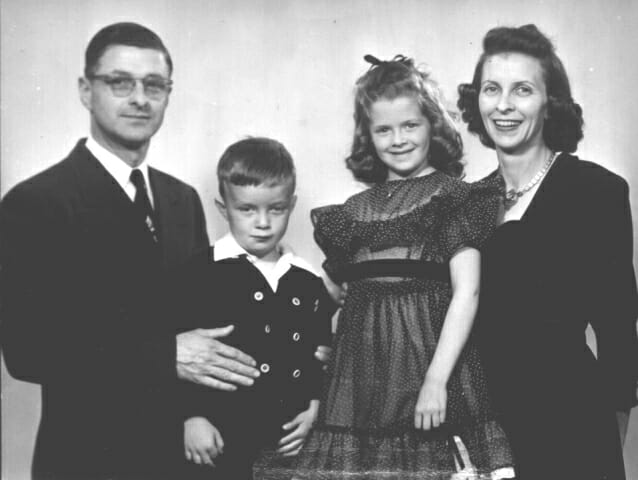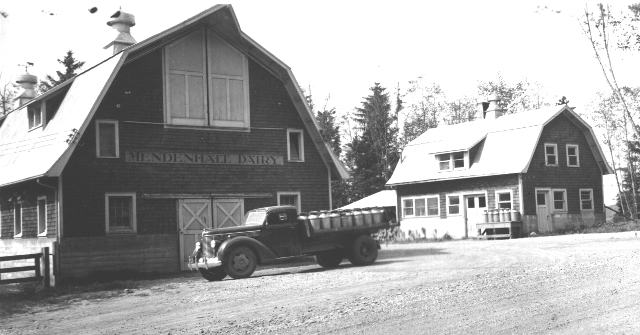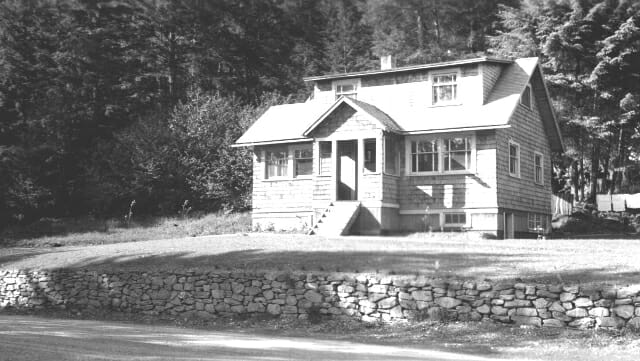Gastineau Channel Memories
Danner, George
George Danner, Jr.
My father, George Danner, left his home near Munich, Germany, for Galveston, Texas in 1908. He was quite a handyman and moved to San Francisco to help rebuild the city after the earthquake. In 1909, he was in Skagway, Alaska, working on the water system and in 1910, the lure of gold drew him northward to Circle City. He got employment as a ditch digger, all the while dreaming of striking it rich on his own.
In 1914, like so many early immigrants, Danner returned to Germany to marry his sweetheart, Rosa Maier, and brought her to Alaska. He had intended to follow his dream of finding gold by returning to Circle City after marrying Rosa, but the birth of George Jr. on December 28, 1914, changed his plans. On August 29, 1914, a deed to a fraction of land and a house was issued to George and Rosa Danner from Frank Bach. At the time, my father worked for Lee Smith, a local dairyman, but in about 1917, Dad decided to go into the dairy business for himself and rented the old Knudson Ranch for his dairy operations, which was where the Juneau Airport is now located.
In those days, there was no indoor plumbing. We used the proverbial outhouse and took our weekly bath in a galvanized washtub on the kitchen floor with water heated on the stove. We lived under pretty primitive conditions; no electricity, hence, we got our light from kerosene lamps and lanterns and later gaslights.
At that time, the valley was shared by other dairymen and numerous mink ranchers scattered about. Other enterprises in the area included several fox farms, usually on the surrounding islands, two salmon canneries in Auke Bay and another at the north end of Tee Harbor, and out at Eagle River there lived another rancher who raised vegetables and root crops. In the wintertime, we used a horse and sled to get to town and in the summer, a Model T Ford. Dad hauled the milk to town in ten gallon milk cans and did his bottling at Knudson?s holdings downtown near the present location of the Centennial Building.
The road conditions in those days left much to be desired; one lane wide with turnouts for passing, crooked and full of potholes. Our road was a Forest Service road and run by the government under the Bureau of Public Roads. Their road camp was at Auke Lake where their equipment was kept-pretty crude by today?s standards. A lot of hand work with shovels and wheelbarrows. The roads were washboards and dusty in the summer and in the spring breakup it was nothing but deep ruts. In about 1928-1930, the road was rebuilt and alignment and road surfaces were improved. They took out a lot of curves, like Salmon Creek, where the original road crossed the creek at the present Salmon Bake location. If I remember right, the Glacier Highway was paved in the early 50?s and that eliminated all our problems.
About 1921, we relocated and built a new barn at Salmon Creek at the Wagner homestead, where Wagner Gold Mine was located and where the Salmon Creek salmon bake is located today. From there, Dad still hauled his milk in those same ten-gallon cans to the milk house in town.
In 1922, Dad applied for a homestead with the Forest Service for 132 acres for agricultural purposes. Dad built the finest and most up to date dairy farm of its day in Alaska, at 7 1/2 mile and called it Mendenhall Dairy, where Southeast Veterinary Clinic is presently located. We built a barn, milk house, bunkhouse and residence on the property. This provided for summertime use only. Due to road conditions and the lack of any snow removal abilities, every fall we drove the cattle towards town to winter at Norway Point where we had a second barn and bottling operation. In 1936, when we got electricity, the residence at 7 ? mile became our permanent home.
This is how I grew up, helping Dad with the cows. I attended the old Catholic School for the first three grades, transferred to grade school at the old combined high and grade school on 5th Street at the location of what later became the Legislature Building. As a teenager I took violin lessons from Professor Stumpf and then from the well known instructor Willis Nowell and later played for five years in the Juneau Symphony under Cliff Berg.
It?s interesting to see how many high school kids have cars parked near JDHS these days. In my day, I was one of the few kids who didn?t have to walk to school. That was because I used a horse to deliver milk in the mornings and went straight to school when I finished my deliveries. There were only two boys who drove a car in those days. One was Zalmain Gross and the other, Ben Mullen, grandson of B.M. Behrends.
Eventually we got a school bus. The first was a Model T Ford with a bench seat along each side with canvas curtains for our protection. Its route went from Salmon Creek to the Fifth Street School. It was owned by Tom Shearer (who had two kids) and Walter Hellan. The next bus, owned by Bert Johnson, was an enclosed Model A Ford school bus and it started from Auke Lake. Pete and Ed Christensen owned the next bus system and they operated two buses from the Valley and one from Thane. Finally they sold their buses toEric Lindegaard and the busline is now operated by his son Eric.
Some friends and I had owned a small plane together that we flew out of the cow pasture where Fred Meyer is now. After graduating from Juneau High School in 1934, I attended the University of Washington until the war broke out in Europe. I quit college to join the Air Force and become a pilot. When that didn?t work out, I ended up spending the war working at Consolidated Aircraft in San Diego, California. My contribution to the war effort came in the form of designing and drafting aircraft, working on the PBYs and B24s. Our plant was huge, covering well over ten acres and I remember one day meeting one of the Rosie-the-Riveter gals who delivered parts on a bicycle. Her name was Mabel Nelson and in 1941 she became my wife.
Mom had gotten ill some years before and was in a hospital in California. Between visits to her and back to his family in Germany, Dad was ready for a break from dairy farming. After the war, Mabes and I moved back to Juneau to help him out with his responsibilities. Mendenhall Dairy had joined in a co-op with several other dairies to become Juneau Dairies, Inc. and I was employed at their creamery as plant manager from 1945-1948 at the foot of Twelfth Street where the Juneau School Superintendent?s offices are today.
In 1948, I joined the Forest Service as an engineer. In those days, I was one of eight employees in engineering and we didn?t have the budgets they do today. One of my jobs was to design and build Forest Service cabins out at some of the lakes in the area, but we didn?t get a budget for materials. We had to use whatever materials we could find. I also drew maps, but I didn?t have one of those big fancy computers and it was before satellite photography. I used a pencil, slide rule and notes from the surveyor.
During the time I worked for the Forest Service, I joined the Juneau Lions Club as a charter member. During its formative years, Del Hanks, the local Scout executive, with the backing of the Lions, started the Gold Medal Basketball Tournament. Reverend Walter Soboleff, also a charter member of the club, assisted in this endeavor. It was a small beginning to the going concern it is today.
I?ve fished every Golden North Salmon Derby except for one in 1971. I had a heart attack that year and wasn?t allowed to go out on my boat, doctor?s orders. Instead I sat on the dock in my lawn chair and watched everyone bring in their catch. I still enjoy cruising in my boat and doing a little fishing with my son, Tracy, or my grandson-in-law, Javier.
In 1955, Mabes and I built our house at Norway Point, where I still live today. We had two children, Linnus Louise and George Danner III who is called Tracy. Linnus is a teacher, and lives with her husband Steve Williams in Haines. Tracy and his wife Ruth live in Juneau and he is chief engineer on the ferry LeConte. Now my children?s children are grown and going their own ways. I even have a great grandson now. Where does the time go?
I?ve been a widower since 1988, and live the bachelor?s life with my cat, Gypsy, and my little dog, Lucy, to keep me company. But I don?t spend much time sitting at home, except during baseball season, especially the playoffs. Every day has a different purpose. Wednesdays I have coffee with the boys from the Forest Service. Tuesdays are dinner at Tracy?s house. Sundays I visit other special friends. And nearly every day finds me driving my little red Ford Escort around with Lucy as my co-pilot and we go anywhere the road goes. These days, that?s a lot further than it used to be.
 |
|
 |
|
 |
|
